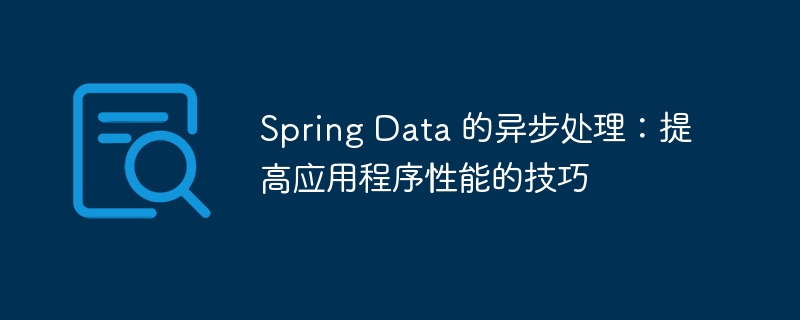

php editor Yuzai brought an article about Spring Data asynchronous processing, which will share how to use asynchronous processing techniques to improve application performance. By deeply understanding the asynchronous operation mechanism of the Spring Data framework, we can optimize the data query and processing process, thereby improving the efficiency and response speed of the application and providing users with a better experience. Let’s explore these tips together and discover how you can leverage asynchronous processing in Spring Data to improve application performance!
To enable asynchronous processing in spring Data, you can use the @Async annotation. This annotation can be attached to a method to cause it to execute in a separate thread. For example:
@Async
public void doSomethingAsync() {
// Operations performed asynchronously
}The above code creates an asynchronous method named doSomethingAsync. When this method is called, it will be started in a new thread, allowing the main thread to continue executing.
Manage concurrency
When using asynchronous methods, managing concurrency is critical. Spring Data provides a variety of mechanisms to help manage concurrency, including:
Use CompletableFuture
CompletableFuture is a class introduced in Java 8 to represent the results of asynchronous operations. It provides callback methods that allow operations to be performed after the asynchronous operation has completed. For example:
CompletableFuture<String> future = doSomethingAsync();
future.whenComplete((result, exception) -> {
//Execute this after the operation completes
});The above code creates a CompletableFuture object that represents the result of the asynchronous method doSomethingAsync. The whenComplete method specifies a callback that is executed after the operation is completed.
Avoid deadlock
When using asynchronous processing, you need to pay attention to avoid dead locks. Deadlock can occur when two or more threads wait for each other. For example, if an asynchronous method needs to get data from the main thread, a deadlock may occur because the main thread is waiting for the asynchronous method to complete.
To avoid deadlock, you can use the following techniques:
get() method to obtain the results of asynchronous operations blockingly, but be careful about the risk of deadlock. Monitoring asynchronous operations
MonitoringAsynchronous operations are critical to identifying potential issues and bottlenecks. Spring Data provides a variety of tools to help monitor asynchronous operations, including:
benefit
Asynchronous processing in Spring Data provides the following benefits:
Best Practices
Best practices when using asynchronous processing in Spring Data include:
CompletableFuture to represent the results of asynchronous operations. The above is the detailed content of Asynchronous processing with Spring Data: Tips for improving application performance. For more information, please follow other related articles on the PHP Chinese website!
 C# Tutorial
C# Tutorial
 Unknown error 3004 solution
Unknown error 3004 solution
 winkawaksrom
winkawaksrom
 What is the inscription in the blockchain?
What is the inscription in the blockchain?
 How to solve cpu fan error
How to solve cpu fan error
 What should I do if the web video cannot be opened?
What should I do if the web video cannot be opened?
 How to solve the problem that cad cannot be copied to the clipboard
How to solve the problem that cad cannot be copied to the clipboard
 What to do if the CPU temperature is too high
What to do if the CPU temperature is too high
 How to install ssl certificate
How to install ssl certificate




